#organization functions
Explore tagged Tumblr posts
Text
Syboulette Dorm Territory: Computer, TV (with games and stand) and Wall Organizer for The Sims

These are 4to2 conversions from Syboulette, low poly. Computer and Tv are functional, I also added a slot on the tv stand so you can put there the telephone or something else. There is also a Monique Computer Hack version but CHOOSE ONLY ONE.
DOWNLOAD HERE
-------------------------------
If you want to support my creations, you can send me a donation with Paypal or Ko-fi ☕ If you want to ask for a Paid Commission, HERE you can find more details. Thank you ❤️
#ts2#the sims 2#sims 2 cc#sims 2 download#the sims 2 cc#ts2 download#4to2#4to2 conversion#buy mode#computer#tv#tv stand#organizer#functional
1K notes
·
View notes
Text
post about the upd8 that is not gonna make sense -> thinking about john and dave coming to the same conclusion through vastly different routes (a common theme!!!). they need to leave the narrative and attend to their greater purpose, even if it means leaving everything behind.
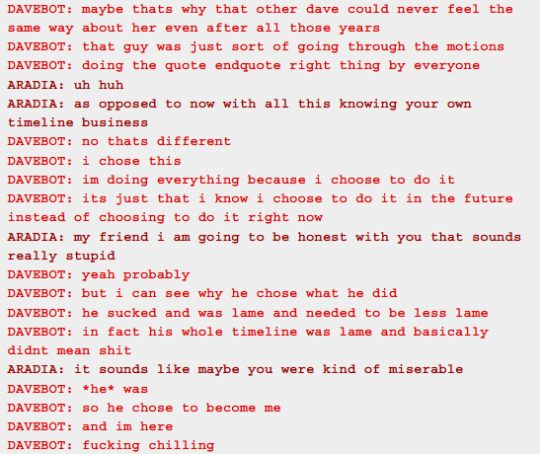
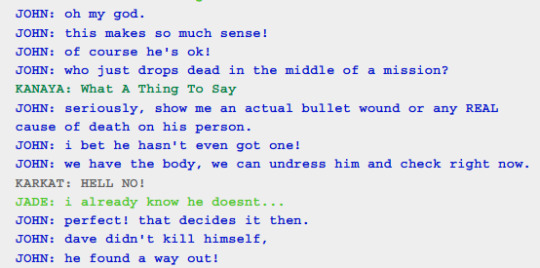
likeeee dave left everything behind to escape the feeling that john has been pointing out for ages now. i think they're both stupid about it in their own ways (obviously!) but it's crazy how mirrored they end up being with this feeling. they're offered the choice for freedom of their "normal" narrative at the cost of everything, and they both aren't hesitating to answer.


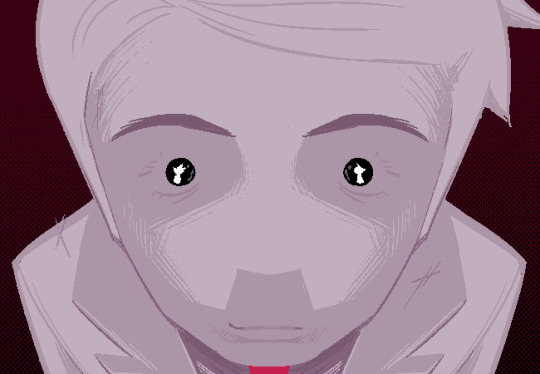
just look at both of them witnessing the changes that happened in this busted ass adult timeline! they are both at their lowest here- dave's discarded dead body left with his abandoned wife (that his ex-bf didn't even know about!) and john with his realization that his friends and family all have drastically different ideas of what the game Meant. the choice to Literally reflect the conflict in their eyes is nuts. i'm goign crazy omfmg
anyway there's no real thesis here but here's some random and tangentially related thoughts. i've been pondering the truth that jegbert and dave NEED to be in the same timeline + in service to the narrative for the story to be stabilized for eons now, and this sort of gets into that a little. davesprite established this when he came back to keep john alive and stop terezi's games, or when john goes on the scarfquest and has to keep vriska alive. i wonder if this is a subversive callback to that of sorts......... something something dave is a tool again (like terezi) and egbert once again the catalyst for major narrative change (like VRISKA). WHATEVER!
#hs#hsbc#upd8#upd8 spoilers#sorry for hsbc im just dialed tf in to pepsicola and also jegbert things#the worlds least organized thought blast#i really think john and dave NEED to be in the same timeline for the narrative to function fully in general#even if theyre seperated :[#johndave#LOL#vrisrezi#egbert post#dave post#vriska post#terezi post#mine
110 notes
·
View notes
Text
akutagawa: how did u know it was me
atsushi: i have the sound of your footsteps, your breathing, and your heartbeat memorized
akutagawa:
#can u memorize someones heartbeat#i mean i dont think its distinct#but if there was a way than atsushi would do it#maybe just the sounds of his organs functioning#sskk#shin soukoku
499 notes
·
View notes
Text
KARLEEEN CLOTHES KARLEEEN CLOTHES!!!!!!!!!


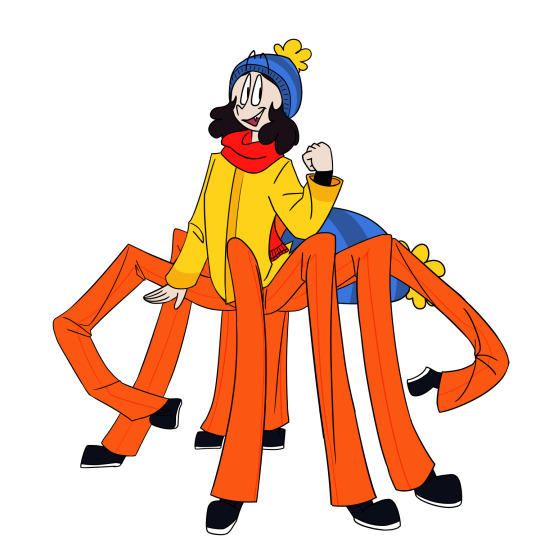


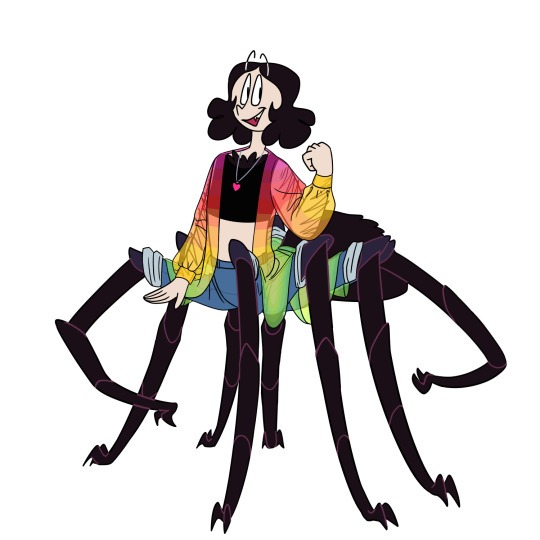
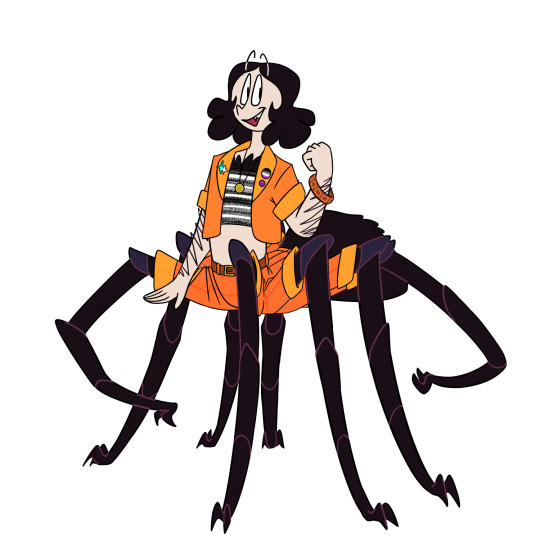
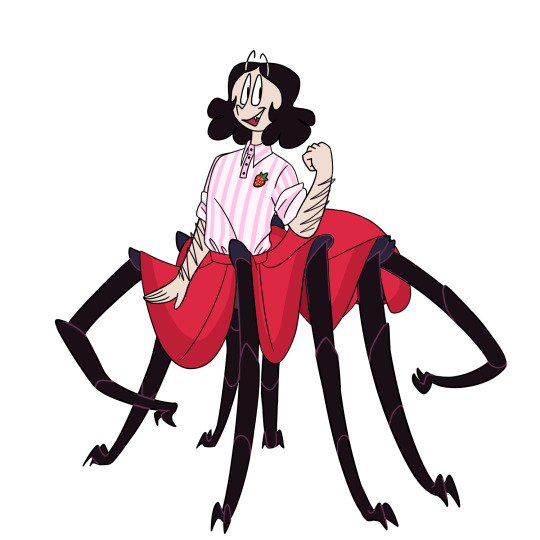
I've been itching to redraw Karleeen's various outfits and design her new ones since forever and now I actually sat down and did it over the past few days. I wonder what her favourite colours might be !!
Not much to say here that wouldn't be obvious. When it's cold, Karleeen wears more clothes, and when it's warmer, she prefers to be barefoot and wears less clothes. They don't always cover her abdomen because culturally having your abdomen (arachnid, insect or otherwise) exposed is the same as wearing a top or a short shirt that leaves your human stomach exposed, since taurs don't have anatomy that's one to one with their "species of inspiration". Karleeen's pants tend to be loose because her legs can bend at so many places, and they open at the top (at the top of the cephalothorax or "spider back")!
#why did i bring up that taur anatomy isnt the same as with the original animals in tandem with not wearing clothes on the abdomen?#if you know you know#anyway karleeen in some of her various clothes!!! she wears the clothes on her reference sheet “the most” but she has variety too :)#also i wanted to illustrate how like a normal jacket works (besides the winter sports jacket where the assumption is that you have outdoor#pants too)#you dont want snow and rain to ruin your pants and... hmm. im not too sure what to call her “second shirt” on her abdomen#because it really just functions like a shirt. keeps her organs warm#but its not like... a shirt. you know? no arm holes no nothing and she already has a shirt on her upper body#mmmm ill think about it.#since i didnt draw her default outfit (yet?) and havent really drawn it in 3/4 view; in that one karleeens skirt reaches -#about the midpoint of her abdomen#in these examples she has little bit longer skirts. and she always wears shorts or leggings underneath#and she likes having pins and necklaces and other things :)#my art#art#sirpaverse#karleeen#spider#spider centaur#spidertaur#not fish
86 notes
·
View notes
Text
obsessed with the port mafia executives. verlaine never leaves the basement he exiled himself to. there’s a constant open position because their boss refuses to hire anyone new. everyone hates ace and he spends most his time on a random ship until he dies. the only ones doing any work are kouyou and chuuya unless they’re currently busy being kidnapped or stuck in a book
628 notes
·
View notes
Text






NEW | NEW | NEW Superfood Snack Balls - The perfect complement to enjoy with your favorite M-PWR-supercharged coffee, tea, and even your healthy smoothies!
Introducing BOOST BITES!
Organic | Non-GMO | Vegan-Friendly - Featuring Organic Dates, Functional Mushrooms, and other delicious ingredients
Three initial flavors: Blueberry Muffin, Fudge Brownie, Peanut Butter & Jelly
Learn more about BOOST BITES: https://buoyantbrands.com/collections/boost-bites
#superfoods#healthylifestyle#healthyfood#healthy eating#coffee time#coffee lover#non gmo#coffee house#organic#functional mushrooms#coffee creamer#snacks#healthy snack#snacktime#energy boost#smoothies#coffee shop#coffee#coffee addict#tea time#tea
176 notes
·
View notes
Text
spiderpeople that could defeat spot first try:
1. spider-ham (cartoon logic dictates that he can just pick up the holes)
2. sun-spider (disabled solidarity. would probably get spot to come to the realization that hes 100% disabled and be empathetic about it)
3. spider-punk (would explain that a majority of spots problems originate from the shitty system hes in and that capitalism is the problem, not miles)
#atsv#sun spider#spider punk#spider ham#spiderman across the spiderverse#across the spiderverse#the spot#spot#johnathon ohnn#once again spot 👏 is 👏 disabled 👏👏👏#spider punk and sun spider teaming up against spot would end him instantly#youre disabled + capitalism is evil + ratio#(i dont mean that as in 'disability is bad'i mean that as in a lot of his troubles and the mistreatment he experiences is because#people are shitty to disabled people#especially visibly ones#and i mean. johns body got fucked up by the explosion+dark matter and people are cruel to him because of his unsettling/''funny'' appearanc#also we can discuss all day the possibilities of how he mustve had to adapt to all the ways his body changed and how#hes missing organs and very likely had to relearn a lot of how his body functions#but looking purely at canon spot outright calls his holes a curse and has been shown to be inconvenienced by them several times over#hes also brought up how nobody is willing to hire him#so....idk yeah the system and how it treats disabled people (especially those that look different) is fucked up. sunspider and spiderpunk#get his ass)#charlotte webber#I FORGOT HER NAME SORRY#hobie brown
956 notes
·
View notes
Text
Who gets to be human? On Black geographies, damned people living in inhospitable places, other ways of knowing and being, and racist legacy of European academic epistemologies.
---
---
The idea of the plantation is migratory. [...] Past colonial encounters created material and imaginative geographies that reified global segregations through “damning” the spaces long occupied by Man's human others. Here, damning can be understood in two interlocking ways: as a fencing in and as a condemnation of racial-sexual difference. The uninhabitable - in particular, the landmasses occupied by those who, in the fifteenth and sixteenth centuries, were unimaginable, both spatially and corporeally - is the geographic (non)location through which the plantation emerged. From Caliban's “uninhabited” island in Shakespeare's The Tempest, to the regions within Africa identified as too hot to be livable, the landmasses deemed uninhabitable presented a geographic predicament upon “discovery.” [...] [A] "new symbolic construct of race," which coincided with post-1492 colonial arrangements, organized much of the world according to a racial logic. [...] The colonial enactment of geographic knowledge mapped “a normal way of life” through measuring different degrees of humanness and attaching different versions of the human to different places. […] [I]n the sites of toxicity, environmental decay, pollution […] inhabited by impoverished communities […] the [current] geographies of the racial other are emptied out of life precisely because the historical constitution of these geographies has cast them as lands of no one. So in our present moment, some live in the unlivable, and to live in the unlivable condemns the geographies of marginalized to death over and over again. Life, then, is extracted from particular regions […]. If we believe that the city [the prison, the resort, other "postcolonial spaces"] is the commercial expression of the plantation and its marginalized masses, and that the plantation is a persistent but ugly blueprint of our contemporary spatial troubles, Wynter's essay asks that we seek out secretive histories […]. [R]acial violence haunts, [...] the struggles we face, intellectually, are a continuation of plantation narratives that dichotimize geographies into us/them and hide secretive histories that undo the teleological [...] underpinnings of [colonial, imperial, modern] spatiality.
Text by: Katherine McKittrick. “Plantation Futures.” Small Axe, Volume 17, Number 3, November 2013 (No. 42), pages 1-15. [Emphasis mine.]
---
---
Registering the marine world as central to the making of modernity - from slave ships and sea-borne empires to container logistics and the industrialized extraction of its resources (from fish to fossil fuels) - we encounter the constant of colonialism in the haunting racism that produces the violent grammar of inhospitality, today etched on the body of the contemporary migrant. [...] This is to interrupt and rework Occidental historiography, sociology, and philosophy, and to puncture their faith in rendering the world transparent to their will. […] Promoting the instability of critical language is to take responsibility for what Achille Mbembe calls the becoming-black of the world: where the production of subjection provokes alternative knowledge, practices, and politics […]. Today the increasing use of drones in the Mediterranean as part of the technology of governance marks the latest abandonment of social responsibility to the bio-surveillance of unwanted bodies and discarded lives. Smart borders take migrants far below the category of “bare life,” [...] and extends the racial profiling written into the historical premises that betray their deep incubation in the refusal to register the languages and limits of the white myths [...]. From the Black Atlantic to the Black Mediterranean: seas of dispossession and unbelonging have constantly demonstrated the political, juridical, and onto-epistemological limits of modernity. They promote a constant critique of the epistemic foundations of Western [colonial "liberalism"]. Those on the water, the wretched of the sea, the damned [...], who cannot source their identity in the territory of the nation-state, are without rights. They have no social [...] validity. [...] Yet they simultaneously [...] exist, persist, and resist. [...] The algorithm sputters in the dark while cut-up, bricolage, collage, and montage work the critical gaps [...]. The archives unwind to expose other computations of time and further folds in space: the promise of foreign cartographies [...].
Text by: Iain Chambers. A section by Chambers in the essay co-authored by Tiziana Terranova and Iain Chambers. “Technology, Postcoloniality, and the Mediterranean.” e-flux Journal Issue #123. December 2021. [Emphasis mine.]
---
---
[T]he framing of the inhumanities forces a reckoning with the humanist liberal subject that orders the humanities: an invisible and indivisible white subject position [...]. In Césaire’s (2000 [1972]) Discourse on Colonialism, he suggested that “at the very time when it most often mouths the word, the West has never been further from being able to live a true humanism [...]”. In another searing critique of [White, European, liberal/colonial] humanism, Fanon (1961) tied the unrealized figure of a true humanism to the earth, as a wretched counterpoint, whereby the inhuman residues of the colonial project abide as discarded matter […]. Those blackened colonial afterlives in “modernity’s project of unfreedom” (Walcott 2014, 94) are still very much present in the political geologies of climate change vulnerabilities, the wasting effects of racial capitalism, and neo-extractivist economies […]. The narrative arc of humanism, Scott (2000) suggested in conversation with Wynter, is often told as a kind of European coming-of-age story. […] The Anthropocene discourse follows the same coming-of-age humanist script [...]. Sylvia Wynter, W.E.B. DuBois, and Achille Mbembe all showed how that genealogy of man [as universal concept] was underscored by the racial division of life and nonlife. […] In its simplest iteration, there are forms of life on one side and nonlife on the other; nonlife that is constituted through death, and more recently in Mbembe and Povinelli’s writing through forms of social death, exhaustion, and extinguishment, wherein nonlife emerges as a zone of governance. The gravitational pull that centers these divisions between life and nonlife is the human subject as it is conceived through a Western normative frame [...]. As new forms of racialized beings were articulated through sixteenth- through nineteenth-century paleontology in the context of colonialism, geology was also articulating new origins of the earth, as well as forming the material praxis of their rearrangement (through mining, ecological rearrangements and extractions, and forms of geologic displacements such as plantations, dams, fertilizers, crops, and introduction of “alien” animals). [...] Historically, this normative sphere of humanism was racist and specifically antiblack, and without challenging that history, it remains so, every time the universal or human is invoked. Some of the greatest challenges, of course, came from anticolonial thinkers struggling to make sense of their painful histories in their fullest terms, such as Fanon (1959, 1961), Césaire, Glissant, C. L. R. James and Wynter. As Wynter (2000) commented, “The degradation of concrete humans, that was/is the price of empire, of the kind of humanism that underlies it” (154). For Wynter (2000), “what is called the West [...] begins with the founding of post-1492 Caribbean” (152). Wynter challenged the geographical imaginary that the Americas and Caribbean are somehow an epistemological outside to Western knowledge […].
Text by: Kathryn Yusoff. “The Inhumanities.” Annals of the American Association of Geographers, Volume 11, Issue 3. November 2020. [Emphasis mine.]
---
---
But what becomes of the native-occupied “uninhabitable” zones is a geo-racial reorganization. The “new symbolic construct of race,” which coincided with post-1492 colonial arrangements, was spatially organized according to a new […] logic. […] That is, the uninhabitable […] is underscored by racial and sexual differences. To transform the [land] […], and make this transformation profitable, the land must become a site of racial-sexual regulation, a geography that maps “a normal way of life” […] This is expressed through uneven geographies: spatial arrangements [...]. The inhabitability [...] also produces [...] forms of geographic nonexistence, which differ from what was assumed was "not there." [...] [W]hat Edouard Glissant describes as the "real but long unnoticed" places [...]: cultural sharings, new poetics, new ways of being [...]. Those who occupy the spaces of Otherness are always already encountering space and therefore articulate how genres or modes of humanness are intimately connected to where we/they are ontologically as well as geographically. To return to an earlier discussion, spaces of Otherness are “palpitating with life.” [...]
Text by: Katherine McKittrick. “Demonic Grounds: Sylvia Wynter.” Demonic Grounds: Black Women and The Cartographies of Struggle. 2006. [Emphasis mine.]
#sorry doing this in breakroom at work#tidalectics#black methodologies#really want to also place next to this my summaries of an laura stolers writing on imperialist nostalgia and academic anthropology#as sometimes functioning basically imperial intellectual tourism or entertainment but stuck at work and cant find and edit them#ecologies#multispecies#katherine mckittrick#abolition#kathryn yusoff#geographic imaginaries#indigenous pedagogies#fred moten#pleistocene#my writing i guess#last tag about my writing only there for organizing purposes not to lay claim to their scholarship
58 notes
·
View notes
Note
Screaming and running around in circles in my enclosure bc I’m so excited about your game ✨
THANK YOU... Chocodile is hard at work getting the game ready for its next major beta and we're both stoked to get all the new scenes and features out there! You can follow more progress over at @wishbonegame!
Just for fun, have more Theo screenshots that I haven't posted here yet.
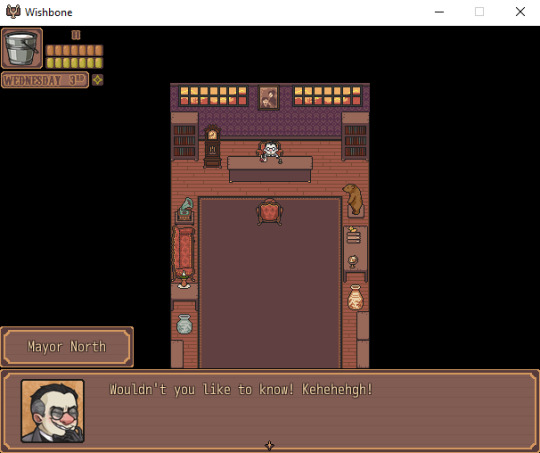

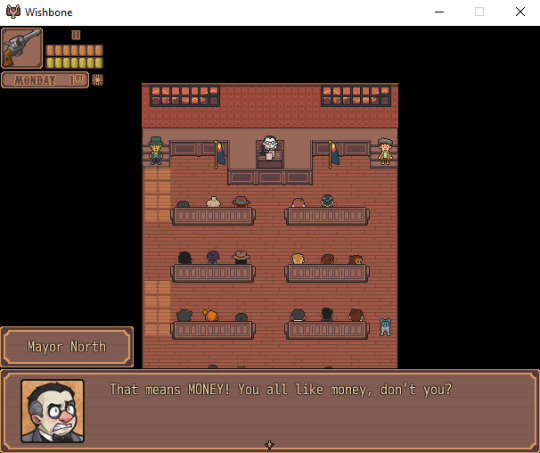
#there are many other funny quotes and characters ofc but theo screenshots are just what i have on hand :P#this one is from 2 months ago and i missed it because i'm VERY BAD AT ORGANIZATION AND COMMUNICATION#god the state of my inbox is a travesty#i wish tumblr inboxes had folders or a search function so i could organize it better#and then continue to not answer things on time because i'm a failure of a human being#thank you nonetheless kind stranger!!#wishbone#theo#asks
47 notes
·
View notes
Text
the main thing that makes me feel like this is covid again is the brain fog. I don't think I get this stupid from a regular cold. I finally remembered to take my morning meds and that enabled me to fix something to eat but then when I decided to also make some tea I completely forgot about the food. was sitting here drinking the tea and going 'mmm... yes... but wait... I'm hungry. why am I hungry? didn't I just fix some soup?" and it's like ah. I did. but I forgot to eat it
#psir#brain fog#my brain is not the most functional organ at the best of times. but this is ridiculous
24 notes
·
View notes
Text
CW : MALE PRESENTING PREGNANCY in the True Detective universe, lmfao so there's another user on this site in the true detective realms who I've seen like, in adjacent passing, on reblogs of other posts talking vaguely about Marty accidentally getting Rust pregnant in 2002 and I've had to pause on this one and contemplate it for a minute because I'm kind of obsessed with it. back in yons years of 2014 and 2015 "mpreg" was obviously not socially acceptable fodder in fandom and it absolutely would NEVER have flown in TD circles, considering half the fandom base at that time would get pissy and ants in their pants just over retired Rust and Marty kissing or having a cat. anyway.
I don't want to steal the other user's AU because I truly know nothing about it or the origins, it may have even been on discord for all I know, I've just seen them mentioning the most basic concept in Tumblr tags. but my mind immediately went to like...Rust hiding a pregnancy from Marty leading up to their fight in 2002, the fight happens and then he REALLY refuses to tell him, and then fucks off to Alaska without telling him about the baby. just to have the kid and raise it without telling anybody out of pure anger and spite. and it fits seamlessly with the 'time is a flat circle' theme because here's Rust, raising a child on his own in the Alaskan wilderness like his Pop did before him. everything we do, we are doomed to repeat again and again, etc.
all this to say, when Rust comes back to Louisiana in 2012 [within the context of this AU] with or without a nine-year-old in tow, the stakes are obviously way different. and he really has to make sure Marty is on his side before he even breathes a single word adjacent to this child's existence. but when he confirms Marty's on his side, and Marty proves his loyalty, and the kid is in safe hands while they finish working the case together...? oh. imagine the introduction. the drama 💋🤌 delicious middle-aged fatherhood 2.0. not even speaking on the part where Rust is the world's most traumatized parent after he lost Sofia at a young age and would lay down his life in a heartbeat for this kid he had with Marty
#I do not like cismale mpreg in my personal space so I guess this is either a/b/o universe or rust transitioned...your choice here#if it's a/b/o he can be hermaphroditic adjacent though with two sets of fully functioning reproductive organs maybe 🤔#(I hope this doesn't make people uncomfortable...I'm just rambling in the tags; sorry. EITHER WAY: GOT PREGNATE)#I can't decide if they have a little boy or a girl but I know Marty won't believe it unless the kid looks just like him#like the tooth gap and blonde curls or something; grey-blue eyes...mini Marty with Rust flourishes#rust x marty#everybody wondering 'can they do it right this time?' the answer is obviously yes who the hell do you think I am#Marty needs his redemption arc and to make amends if he has to crawl on his knees to be involved in this kid's life#true detective
24 notes
·
View notes
Text
While the autopsy scars on Jason are very Cool and Thematic and whimsical and spark joy etc, they have troubling implications for his whole resurrection thing. Bc like they don’t put the organs back where they’re meant to be right, they’re not expecting you’ll need them again
#they put them in a bag and then they put the bag inside#or sometimes they don’t at all#like the organs are taken out and examined they’re not stitched back in a functional way#you feel me? I’m thinking abt this#it was Bruce that did the autopsy wasn’t it.. crazy#need to think abt that more
41 notes
·
View notes
Text
Finally here he is! Iʻve been procrastinating this particular ref for a while now lmao, But I present Lambert, Or rather Grim :) My cult of the lamb, Lamb
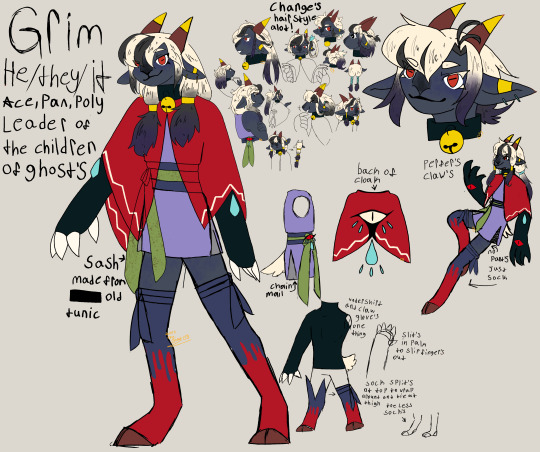
It has a very fun design and I'm really happy how it turned out! and its good to finally have its ref done because it feels like all I'm drawing right now are references (¬_¬")
I also finished a Toyhou.se for it! like always feel free to ask any questions about it, I love talking about my ocʻs :)
#I even uploaded them to art fight since i got in the mood to work on that social page more again#wow a person gains some form of routine and suddenly iʻm a more functional person/sarcastic#lmaoo any way. i defiantly need to draw them more in at least sketches because i love them very much#artists on tumblr#art#character art#oc art#digital art#cotl oc#cotl lamb#cotl#cotl au#i think?#cult of the lamb#character reference#I need to get into a better habit of having a tagging organization system my blog is too much of a mess smh
22 notes
·
View notes
Text
Ok, as previously established, I very much enjoyed Thunderbolts*. This post is in no way trying to minimize the movie or its characters.
however
if I see one more person talking about how it was so groundbreaking to have a superhero on screen where their superpowers don’t magically fix all of their problems and actually give strength to making those problems worse, I am gonna riot I fear.
While I would argue it’s not necessarily groundbreaking to superhero stories, generally. It makes me mad when people say this bc it’s not even groundbreaking to the Marvel universe. This exact concept was literally done so well in Agents of Shield (multiple times!!!!), upwards of like 9+ years ago… like… please I’m in the trenches here
#this is not very well articulated but all I’m saying is agents of shield‼️#Daisy did not almost kill herself just for people to disrespect agents of shield this way 💔#OBVIOUSLY I’m glad Thunderbolts* is reaching people who are in a vulnerable place#that’s what agents of shield did for me#and hey man that’s what media’s all about#my gripe is just with the MCU getting away with robbing AOS of its long overdue recognition 💔#it’s just like you can’t have your cake (kill marvel tv and never acknowledge the characters) and eat it too (steal all their ideas)#if Kevin Fiege and I ever come face to face…. Kevin when I catch you Kevin#for legal reasons I cannot fight and this is a joke#I s’pose I could yell at him tho#agents of shield#aos#i love agents of shield#marvel#marvel mcu#thunderbolts#also lowkey I would argue that if you’re paying attention to a lot of the other movies you’d see that often superpowers aren’t that great#but one thing at a time#maybe if I could organize my thoughts#one time a character in a fanfiction I read described the experience of really low energy executive functioning days as#bowling ball in your head kind-of-days#and I think about that descriptor often#very off topic but I’m just yapping down here at this point
24 notes
·
View notes
Text
Read from the top-down, not side to side:
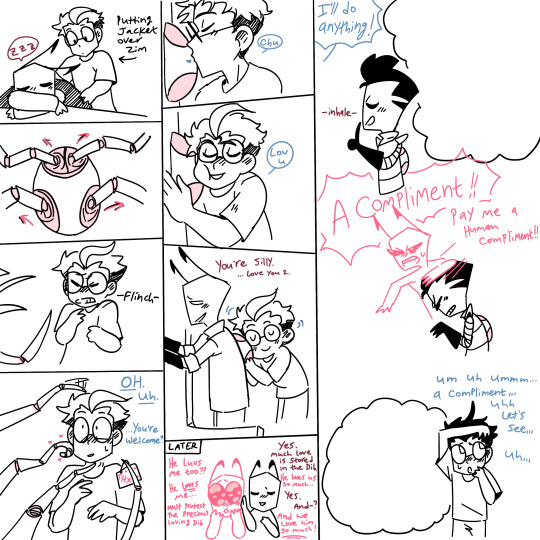
Left strip: the pak is rewarding Dib for taking care of its host 😌
Middle: pak is touched to learn that much love is stored in the Dib 🥺 (Dib views the pak as zim-adjacent and he's not wrong)
Right: that scene from the comics where Dib is begging Zim for poop cola. With blank thought bubbles neither want to actually say, for you to fill in your own blank. I just thought it would be funny if Zim was being a lover boy and the pak is like "NO! Keep it SMALL!" But Dib is ALSO being a little lover boy 😌
#invader zim#iz zim#iz dib#zadr#pak zim#my art#things about the pak that dib is aware of:#that it keeps zim alive by filtering air and basically tells his organs how to function (like a brain)#that it spouts protocols and rules in Zim's head and Zim resists this but sometimes has trouble going against the programming#so dib is aware that the pak IS zim but it's also like... half of zim.#there's two zims.#not quite a split personality as they are largely the same and also the pak can't actually take over. it's just#*a matter of zim listening or not
146 notes
·
View notes